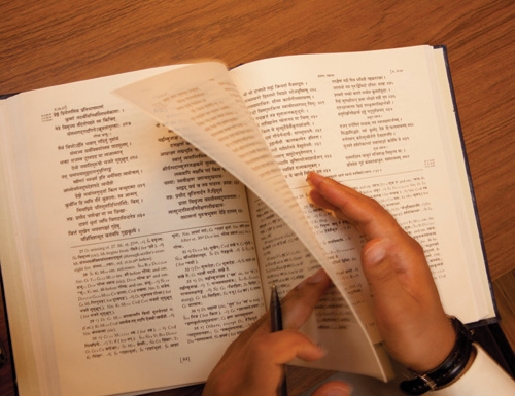Translating devotion
Ravi Gupta works to share joy of a ninth-century Sanskrit holy text
The Bhagavata Purana is to some Hindus what the Bible is to some Christians. It is a work of literature encompassing a rich tradition of poetry and drama, as well as a scientific, technical, philosophical and Hindu religious text. There is only one English translation of the pure Sanskrit work and it’s a technical, bare-bones translation.
That is about to change.
Ravi M. Gupta, associate professor of religious studies at William & Mary, is working on an abridged English translation of the Bhagavata Purana. Fluent in Hindi, English and Sanskrit, Gupta grew up in Boise, Idaho, and is an initiated brahmana priest of the International Society for Krishna Consciousness. He is a major figure in the U.S. Hindu community; he was selected to meet with Pope Benedict XVI in 2008 as a representative of American Hindus.
Gupta’s goal is to produce a translation that will include the artistic and literary elements of the sacred work, which most scholars date to the 9th century. He is working with Kenneth R. Valpey, a colleague from the Oxford Center for Hindu Studies. Their translation will also include a companion volume of scholarly articles which examine the Bhagavata Purana from multiple disciplinary perspectives.
An Ancient text in an ancient language
A “Purana” is a class of Hindu sacred writings comprising popular myths and legends and other traditional lore. Most of the major Puranas are written in Sanskrit which, like Latin and ancient Greek, is considered an archaic language. Again like Latin and ancient Greek, Sanskrit continues to be widely used as a ceremonial language in Hindu religious rituals. Gupta notes that some 10,000 people in India still speak it as their native tongue.
“The Bhagavata Purana is one of the most sophisticated philosophical works of its time, spawning multiple religious traditions for which it serves as the primary sacred text,” Gupta says.
The Bhagavata Purana has long served as the ultimate religious text for Vaishnavas, who focus on Bhakti Yoga, or devotion to the supreme lord expressed through love, with Krishna understood to be the supreme lord. Gupta notes that the work is an important cultural source as well, its verses inspiring countless works of art. Stories of Lord Krishna from his childhood to the Kurukshetra battle in Mahabharata figure in one form or another in Vaishnava temple sculptures, while important Hindu dance types have themes taken from the Bhagavata Purana.
“It stands out as an important piece of world literature, with some of the most beautiful poetry you’ll find in any language,” says Gupta. “It’s an excellent literary piece in terms of poetic ornamentation, alliteration and all kinds of innovative Sanskrit verse meters. And it stands out aesthetically in terms of the imagery and stories that are used.”
Hinduism is not a “religion of the book” where there is a single text held up as sacred, and Gupta explains that there are three texts which have had a shaping influence on India’s history, and specifically on the development of Hinduism.
The first of the three works—the one perhaps most famous in the west—is an epic called the Ra-ma-yana which depicts the duties of relationships, including the legendary love story of Ram and Sita. The second text, the Mahabharata, an epic of life, remains the longest epic in world literature. It contains the Bhagavad Gı-ta-, often regarded as the central text of their religion by Hindus today.
The third work is the Bhagavata Purana.
Last—but not least
Interestingly, the first two texts—the Ra-ma-yana and the Mahabharata—have been read and studied thoroughly in English scholarship whereas the Bhagavata Purana has—according to Gupta—practically been ignored.
“So we decided to open up this treasure trove of Indian lore—of history—of religious culture, knowledge and theology,” he said.
The two-part work—translated verses and companion articles—is slated for publication by Columbia University Press in late 2012. The books are intended to work as a primary and secondary reading, each keyed into the other.
“There will be an abridged translation covering approximately 10-12 percent of the Bhagavata Purana’s 18,000-verse text and the accompanying volume of articles written by different scholars but edited by us,” Gupta said. “Some of those are being written by us too.”
The articles will study the Bhagavata Purana from multiple disciplinary perspectives—from its influence on Indian music and classical Indian dance to its view of cosmology and the concept of time. The translation will include notes drawn from a number of commentaries which Gupta says provide a wealth of all kinds of historical knowledge.
“Each commentary reflects the dominant themes and problems of that era. You get a good sense of what were people struggling with at that particular period in history,” he explains.
True to the original
Gupta and Valpey want their abridged translation to remain as true to the original text as possible. They run into the typical challenges of translators faced with nuanced meanings in the original language that must necessarily lose something in the translation.
“Sometimes a verse can be pregnant with different layers of meaning,” Gupta explains. He adds that just as a Sanskrit word may carry different meanings, “the word in English may have three meanings as well. When you do a translation you often have to choose one layer of meaning.”
 Gupta is employing a number of strategies to incorporate into his translation as much of the original subtleties of meaning that make up much of the artistic and literary elements of the Bhagavata Purana. His goal, he says, is “to help the reader enter these various layers through the translation, notes and introduction.”
Gupta is employing a number of strategies to incorporate into his translation as much of the original subtleties of meaning that make up much of the artistic and literary elements of the Bhagavata Purana. His goal, he says, is “to help the reader enter these various layers through the translation, notes and introduction.”
Sometimes it means translating the verse once for the main text. Then, completely retranslating the verse in a footnote in order to capture the multiple layers of meaning that elude a single translation.
Gupta envisions his translation as a point of entry for other scholars who are interested in the Bhagavata Purana but don’t have the time or the tools to attempt a translation themselves. What’s more, he sees this project as the tip of the iceberg—a much larger project being planned under the auspices of the Oxford Center for Hindu Studies.
“Kenneth Valpey and I envision a consortium of scholars from around the world who will take up different commentaries from different periods of history and work with them—maybe not to translate all of the commentaries, but to study important areas,” he explains.
Over time, Gupta hopes to undertake an historical analysis of these various periods of Indian history and study how the Bhagavata Purana has interacted with other texts and other cultures—exploring ways in which it has migrated to different parts of the world. ![]()
















